engine coolant CADILLAC DEVILLE 1998 7.G Owner's Manual
[x] Cancel search | Manufacturer: CADILLAC, Model Year: 1998, Model line: DEVILLE, Model: CADILLAC DEVILLE 1998 7.GPages: 386, PDF Size: 22.36 MB
Page 271 of 386

Downloaded from www.Manualslib.com manuals search engine 2. Then keep turning the cap, but now push down as
you turn it. Remove the pressure cap.
3. Then fill the coolant surge tar& with the proper
mixture, up to the base
of the filler neck.
5-22
Page 272 of 386
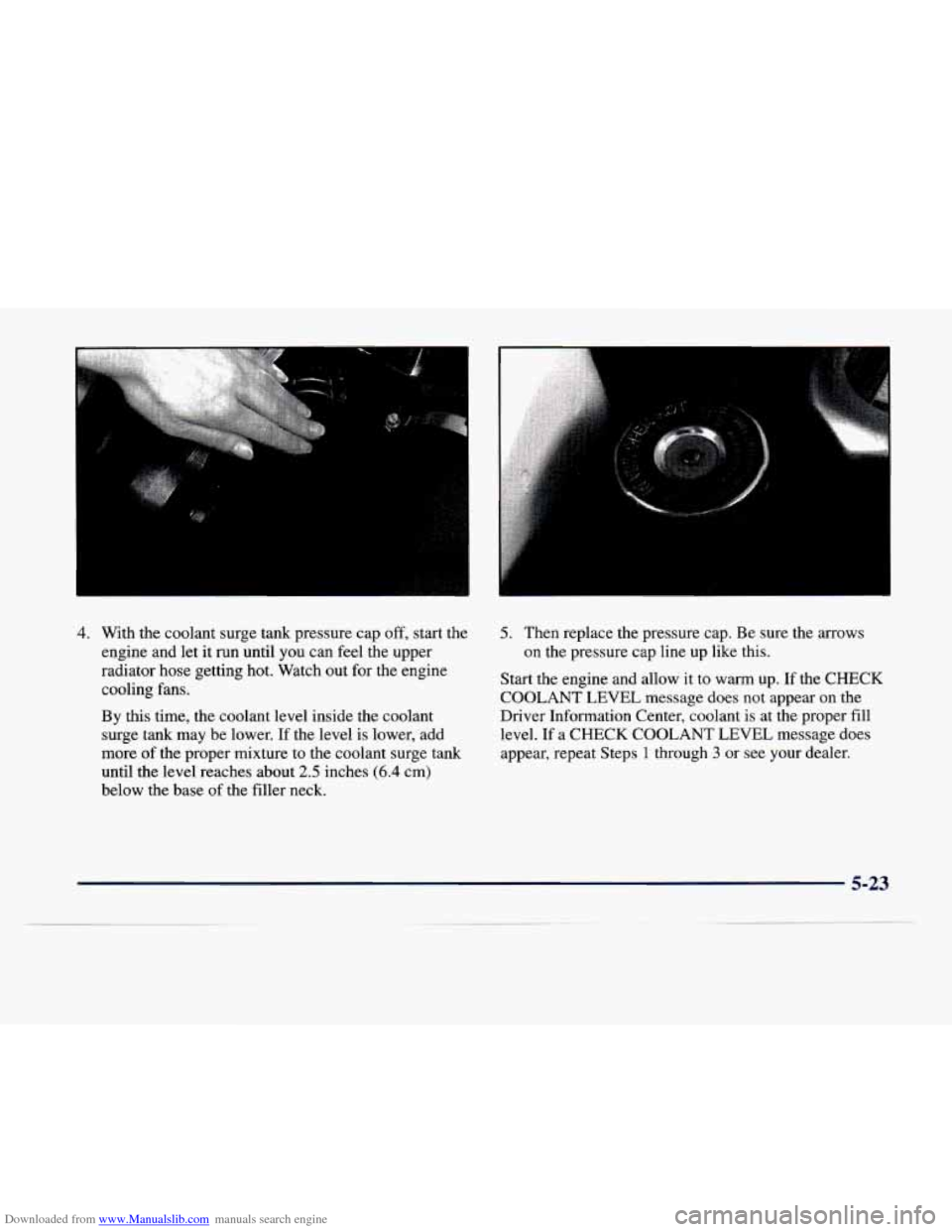
Downloaded from www.Manualslib.com manuals search engine 4. With the coolant surge tank pressure cap off, start the
engine and let it run until
you can feel the upper
radiator hose getting hot. Watch out for the engine
cooling fans.
By this time, the coolant level inside the coolant
surge tank may be lower.
If the level is lower, add
more
of the proper mixture to the coolant surge tank
until the level reaches about
2.5 inches (6.4 cm)
below
the base of the filler neck.
5. Then replace the pressure cap. Be sure the arrows
on
the pressure cap line up like this.
Start the engine and allow it to warm up. If the
CHECK
COOLANT LEVEL message does not appear on the
Driver Information Center, coolant
is at the proper fill
level.
If a CHECK COOLANT LEVEL message does
appear, repeat Steps
1 through 3 or see your dealer.
Page 288 of 386
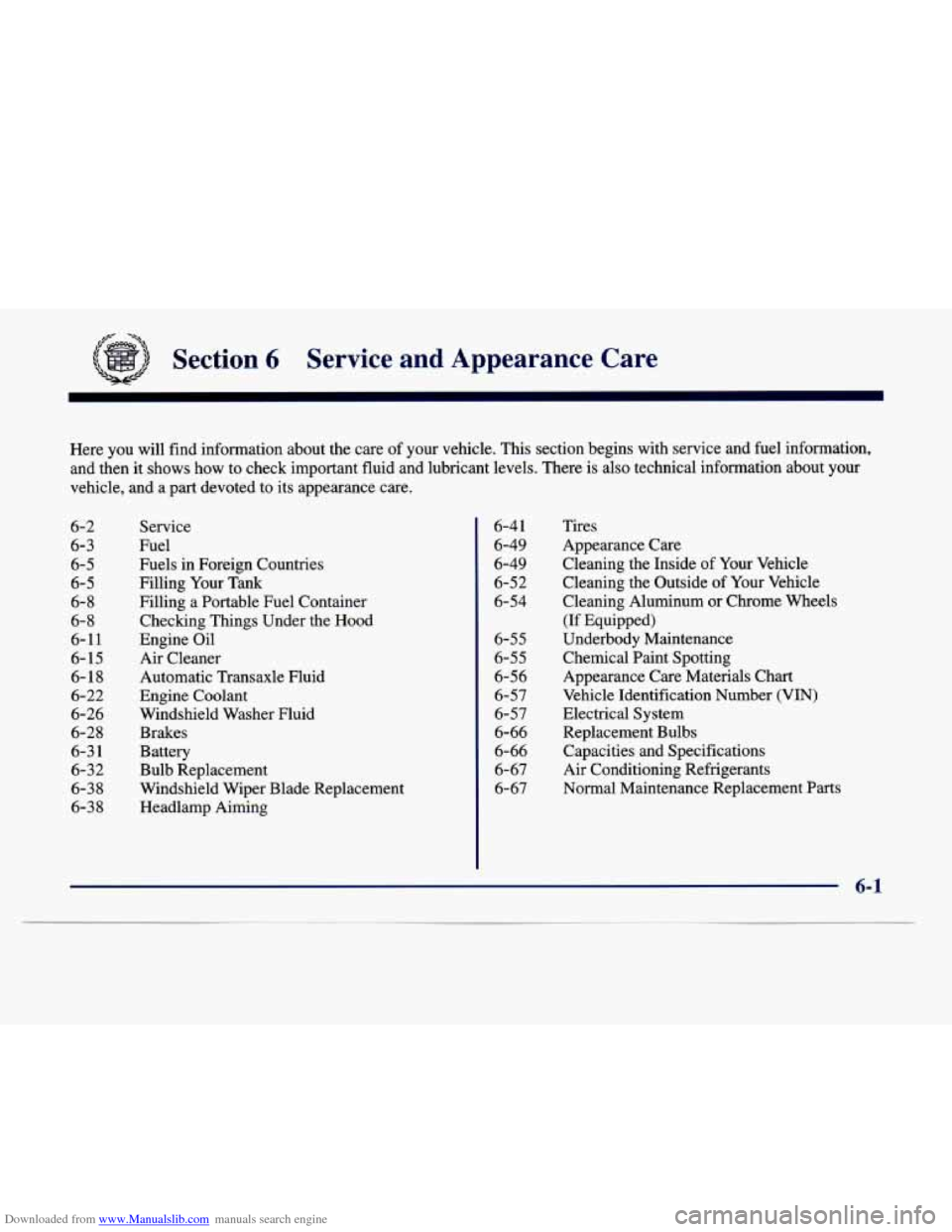
Downloaded from www.Manualslib.com manuals search engine &&* -%%-,
Section 6 Service and Appearance Care
Here you will find information about the care of your vehicle. This section begins with service and fuel informa\
tion,
and then it shows how to check important fluid and lubricant levels. There is also techn\
ical information about your
vehicle, and a part devoted to its appearance care.
6-2
6-3
6-5 6-5
6-8
6-8
6-11
6-15
6-18
6-22
6-26
6-28
6-3 1
6-32
6-3
8
6-3 8
Service
Fuel
Fuels in Foreign Countries Filling Your Tank
Filling a Portable Fuel Container
Checking Things Under the Hood
Engine Oil
Air Cleaner
Automatic Transaxle Fluid
Engine Coolant
Windshield Washer Fluid
Brakes
Battery
Bulb Replacement
Windshield Wiper Blade Replacement Headlamp Aiming 6-4
1
6-49
6-49
6-52
6-54
6-55
6-55
6-56
6-57 6-57
6-66
6-66
6-67
6-67 Tires
Appearance Care
Cleaning the Inside of Your Vehicle
Cleaning the Outside
of Your Vehicle
Cleaning Aluminum or Chrome Wheels
(If Equipped)
Underbody Maintenance
Chemical Paint Spotting
Appearance Care Materials Chart
Vehicle Identification Number (VIN)
Electrical System Replacement Bulbs
Capacities and Specifications
Air Conditioning Refrigerants
Normal Maintenance Replacement
Parts
Page 295 of 386
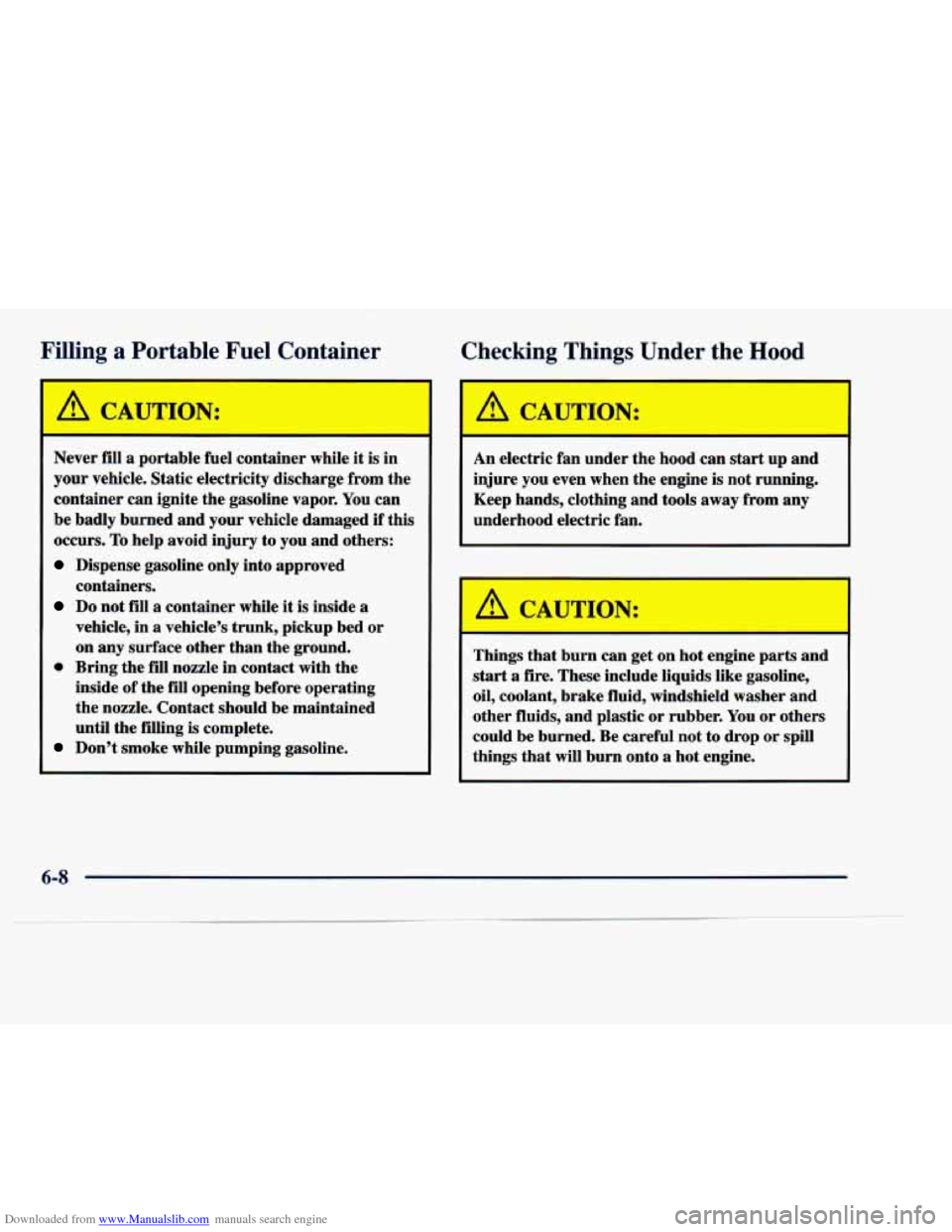
Downloaded from www.Manualslib.com manuals search engine Filling a Portable Fuel Container
-
A CAUTION:
--
Never fill a portable fuel container while it is in
your vehicle, Static electricity discharge from the
container can ignite the gasoline vapor. You can
be badly burned and your vehicle damaged
if this
occurs. To help avoid injury to you and others:
Dispense gasoline only into approved
containers,
Do not fill a container while it is inside a
vehicle, in a vehicle’s trunk, pickup bed or
on any surface other than the ground.
inside
of the fill opening before operating
the nozzle. Contact should be maintained
until the filling
is complete.
0 Bring the fill nozzle in contact with the
Don’t smoke while pumping gasoline.
Checking Things Under the Hood
An electric fan under the hood can start up and
injure you even when the engine
is not running.
Keep hands, clothing and tools
away from any
underhood electric fan.
Things that burn can get on hot engine parts and
start a fire. These include liquids like gasoline,
oil, coolant, brake
fluid, windshield washer and
other
fluids, and plastic or rubber. You or others
could be burned. Be careful not to drop or spill
things that will burn onto a hot engine.
6-8
Page 297 of 386
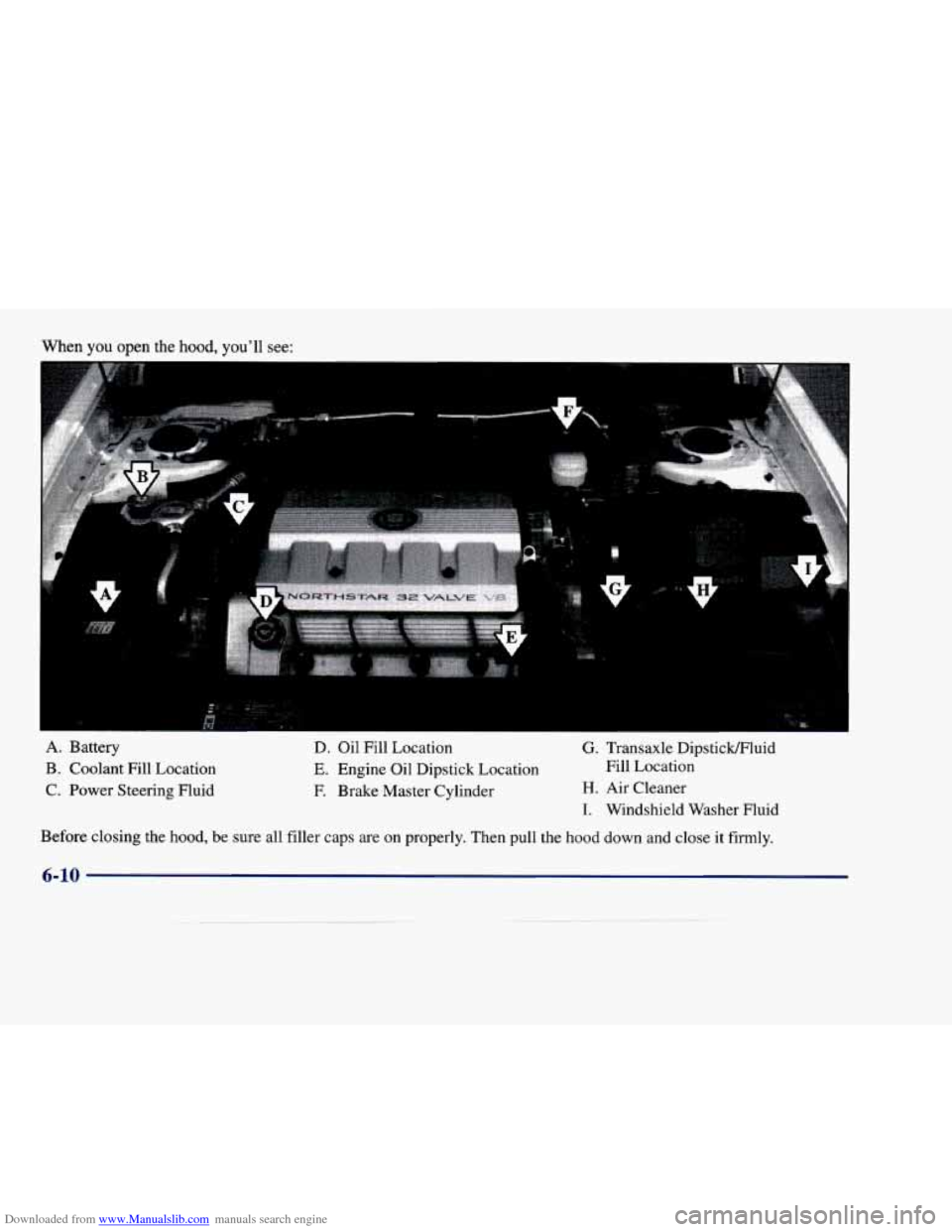
Downloaded from www.Manualslib.com manuals search engine When you open the hood, you'll see:
A. Battery D. Oil Fill Location G. Transaxle DipsticMFluid
B. Coolant Fill Location E. Engine Oil Dipstick Location Fill Location
C. Power Steering Fluid F. Brake Master Cylinder H. Air Cleaner
I. Windshield Washer Fluid
Before closing the hood,
be sure all filler caps are on properly. Then pull the hood down\
and close it firmly.
Page 309 of 386
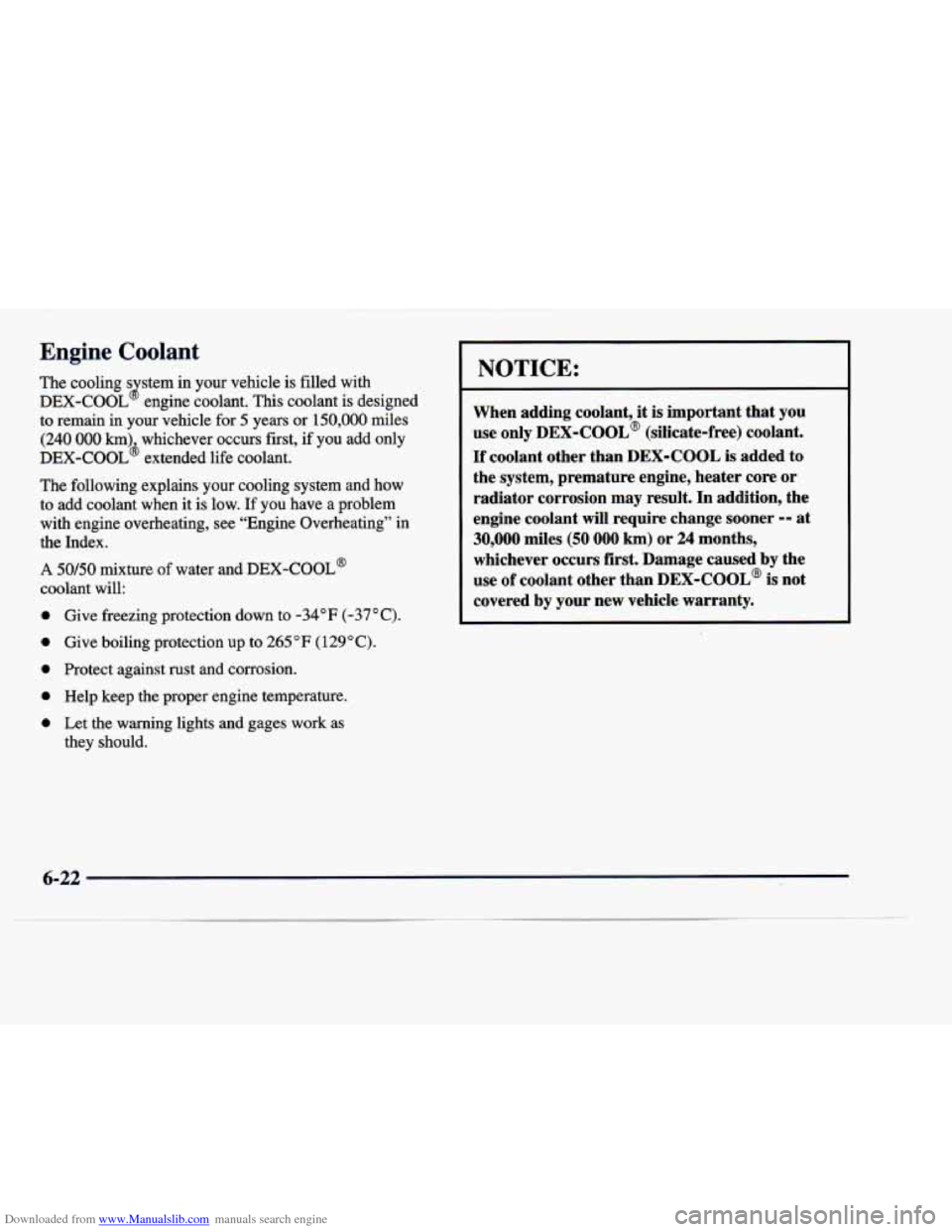
Downloaded from www.Manualslib.com manuals search engine Engine Coolant
The cooling s stem in your vehicle is filled with
DEX-COOL engine coolant.
This coolant is designed
to remain
in your vehicle for 5 years or 150,000 miles
(240 000 km) whichever occurs first, if you add only
DEX-COOL’ extended
life coolant.
B
The following explains your cooling system and how
to add coolant when it is low. If you have a problem
with engine overheating, see “Engine Overheating” in
the Index.
A 50/50 mixture of water and DEX-COOL’
coolant will:
0 Give freezing protection down to -34°F (-37°C).
0 Give boiling protection up to 265 “F ( 129 O C).
0 Protect against rust and corrosion.
0 Help keep the proper engine temperature.
0 Let the warning lights and gages work as
they should.
NOTICE:
When adding coolant, it is important that you
use only DEX-COOL@ (silicate-free) coolant.
If coolant other than DEX-COOL is added to
the system, premature engine, heater core or
radiator corrosion may result. In addition, the
engine coolant will require change sooner
-- at
30,000 miles (50 000 km) or 24 months,
whichever occurs first. Damage caused by the
use
of coolant other than DEX-COOL’ is not
covered by your new vehicle warranty.
6-22
Page 310 of 386

Downloaded from www.Manualslib.com manuals search engine What to Use
Use a mixture of one-half clean water (preferably
distilled) and one-half
DEX-COOL@ coolant which
won’t damage aluminum
parts. If you use this mixture,
you don’t need to add anything else.
I
Adding only plain water to your cooling system
can be dangerous. Plain water, or some other
liquid like alcohol, can boil before the proper
coolant mixture will. Your vehicle’s coolant
warning system
is set for the proper coolant
mixture. With plain water or the wrong mixture,
your engine could get too hot but you wouldn’t
get the overheat warning. Your engine could
catch fire and you or others could be burned.
Use a
50/50 mixture of clean water and
DEX-COOL@ coolant.
NOTICE:
If you use an improper coolant mixture, your
engine could overheat and be badly damaged.
The repair cost wouldn’t be covered by your
warranty.
Too much water in the mixture can
freeze and crack the engine, radiator, heater core
and other parts.
If you have to add coolant more than four times a year,
have your dealer check your cooling system.
NOTICE:
If you use the proper coolant, you don’t have to
add extra inhibitors or additives which claim to
improve the system. These can be harmful.
6-23
Page 311 of 386
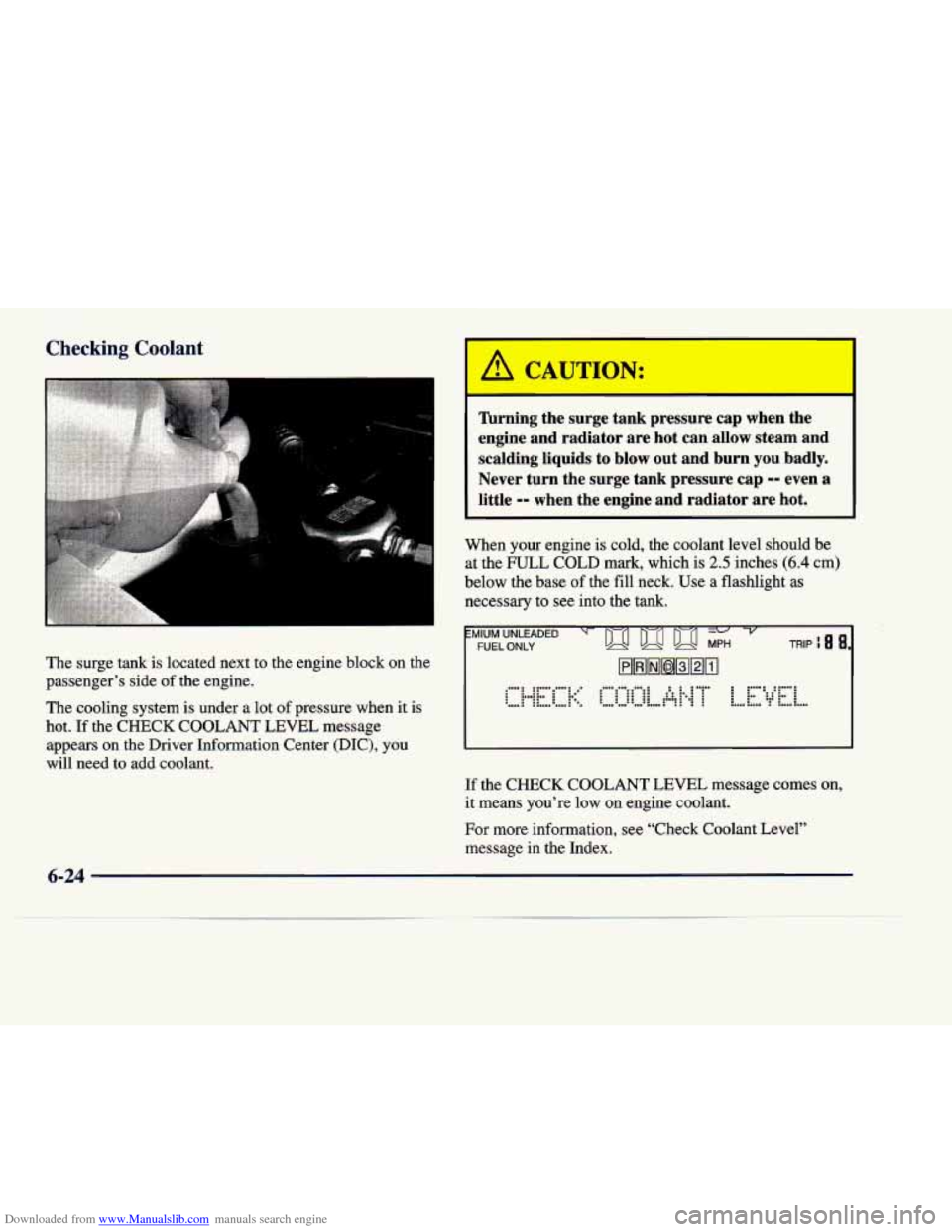
Downloaded from www.Manualslib.com manuals search engine Checking Coolant
L
The surge tank is located next to the engine block on the
passenger's side of the engine.
The cooling system is under a lot of pressure when it is
hot.
If the CHECK COOLANT LEVEL message
appears on the Driver Information Center (DIC), you
will need to add coolant.
l'brning the surge tank pressure cap when the
engine and radiator are hot can allow steam and
scalding liquids to blow
out and burn you badly.
Never turn
the surge tank pressure cap -- even a
little
-- when the engine and radiator are hot.
When your engine is cold, the coolant level should be
at the
FULL COLD mark, which is 2.5 inches (6.4 cm)
below the base
of the fill neck. Use a flashlight as
necessary to
see into the tank.
~MIUM UNLEADED -
-
FUEL ONLY IJIJ DJ DJ MK
HHrnrnrnrn
If the CHECK COOLANT LEVEL message comes on,
it means you're low on engine coolant.
For more information, see "Check Coolant Level"
message in the Index.
Page 312 of 386
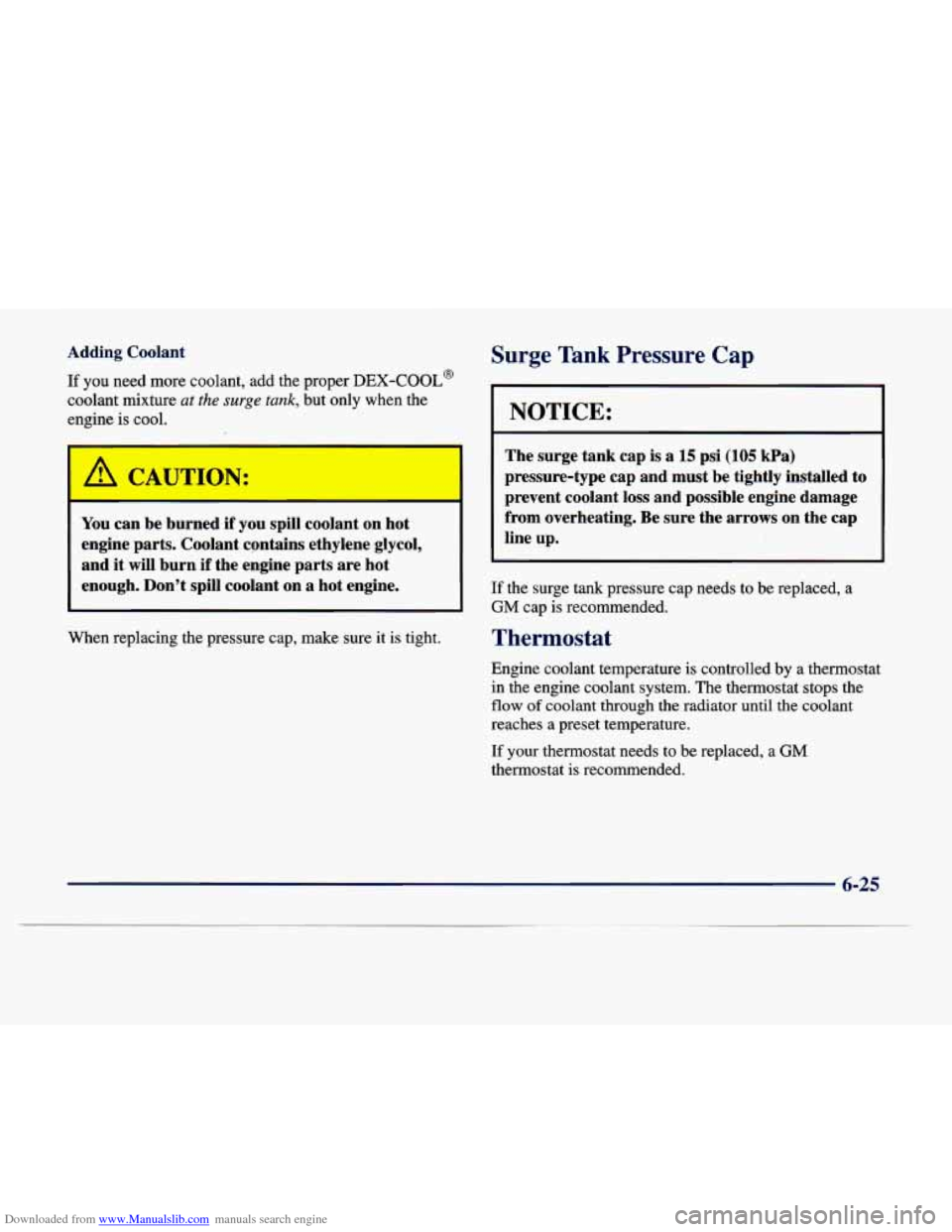
Downloaded from www.Manualslib.com manuals search engine Adding Coolant
If you need more coolant, add the proper DEX-COOL@
coolant mixture at the surge tank, but only when the
engine
is cool.
r-
You can be burned if you spill coolant on hot
engine parts. Coolant contains ethylene glycol, and it will burn if the engine parts are hot
enough. Don’t spill coolant on
a hot engine.
Surge Tank Pressure Cap
I NOTICE:
The surge tank cap is a 15 psi (105 kPa)
pressure-type cap and must be tightly installed to
prevent coolant loss and possible engine damage
from overheating. Be sure the arrows on the cap
line up.
If the surge tank pressure cap needs to be replaced, a
GM cap is recommended.
Thermostat When replacing the pressure cap, make sure it is tight.
Engine coolant temperature is controlled by a thermostat
in the engine coolant system. The thermostat stops the
flow of coolant through the radiator until the coolant
reaches a preset temperature.
If your thermostat needs to be replaced, a GM
thermostat is recommended.
6-25
Page 313 of 386
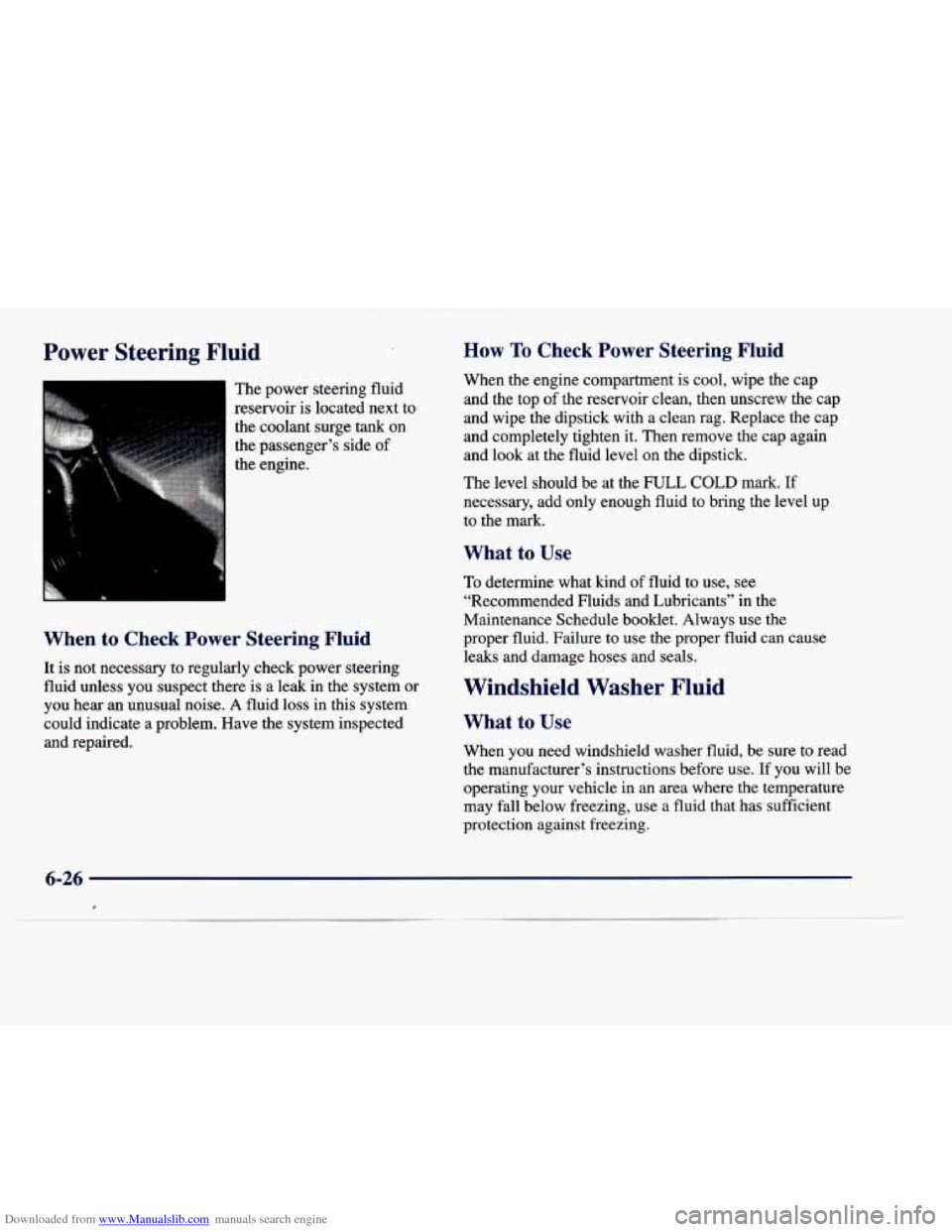
Downloaded from www.Manualslib.com manuals search engine Power Steering Fluid
The power steering fluid
reservoir is located next to
the coolant surge.tank on
the passenger’s side of
the engine.
When to Check Power Steering Fluid
It is not necessary to regularly check power steering
fluid unless you suspect there is a leak in the system or
you hear an unusual noise. A fluid loss in this system
could indicate a problem. Have the system inspected
and repaired.
How To Check Power Steering Fluid
When the engine compartment is cool, wipe the cap
and the top
of the reservoir clean, then unscrew the cap
and wipe the dipstick with a clean rag. Replace the cap
and completely tighten it. Then remove the cap again
and look at the fluid level on the dipstick.
The level should be at the
FULL COLD mark. If
necessary, add only enough fluid to bring the level up
to the mark.
What to Use
To determine what kind of fluid to use, see
“Recommended Fluids and Lubricants” in the
Maintenance Schedule booklet. Always use the
proper fluid. Failure to use the proper fluid can cause
leaks and damage hoses and seals.
Windshield Washer Fluid
What to Use
When you need windshield washer fluid, be sure to read
the manufacturer’s instructions before use.
If you will be
operating your vehicle in an area where the temperature
may fall below freezing, use a fluid that has sufficient
protection against freezing.
6-26
I